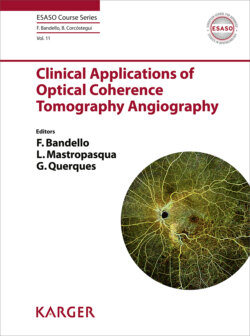Читать книгу Clinical Applications of Optical Coherence Tomography Angiography - Группа авторов - Страница 13
На сайте Литреса книга снята с продажи.
Multimodal Imaging of AMD
ОглавлениеPrior to the introduction of fundus autofluorescence, color fundus photography was the gold standard for evaluation of AMD [20, 21]. More recently, fundus autofluorescence has been used in the evaluation of patients with dry AMD, and especially to measure and to prognosticate macular atrophy [22, 23]. However, the paradigm is slowly shifting in the favor of optical coherence tomography (OCT) [20, 24]. OCT has been used to qualitatively evaluate for dry AMD, as well as to measure drusen volume, which is associated with risk of progression of dry AMD [25]. It can also be used to evaluate the characteristics of drusen that are associated with a higher risk of progression to advanced dry AMD, as well as exudative AMD [26, 27]. Moreover, OCT can also be used to look for reticular pseudodrusen (RPD), which have been associated with a higher risk of choroidal atrophy and of progression of AMD [28–30]. The en face image generated after a volumetric scan can be used to delineate areas of atrophy, with sub-RPE illumination serving to highlight the area of atrophy [31, 32].
More recently, OCT angiography (OCTA) has also been used in the evaluation of patients with AMD. The changes seen on OCTA in the various stages of the disease are described below.
